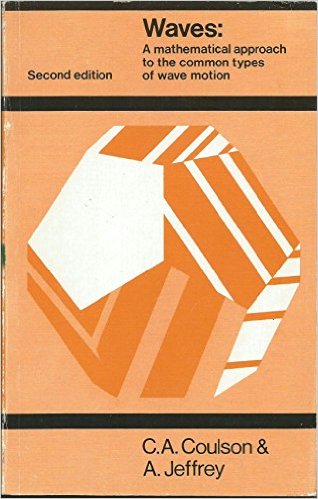
C. A. Coulson, Waves, a mathematical account of the common types of wave motion, originally published 1941.
On December 13, 1910, British applied mathematician and theoretical chemist Charles Coulson was born. Coulson was as a pioneer of the application of the quantum theory of valency to problems of molecular structure, dynamics and reactivity. He is known for the application of molecular orbital theory to chemical bonding, the electronic structures of molecules and the concept of partial valency, and developed many mathematical techniques for solving chemical and physical problems.
Charles Coulson – Early Years
Charles Alfred Coulson was born into a religious Methodist home in Dudley, England, to Alfred Coulson, the Principal of Dudley Technical College and Superintendent of the Methodist Sunday School, and Annie Sincere Hancock, a Headmistress of Tipton Elementary School. In 1920, Coulson’s father was appointed Superintendent of Technical Colleges for the South-West of England, and the family moved to Bristol, where Charles attended the XIV Preparatory School, followed by Clifton College that placed a strong emphasis on science and mathematics. Coulson’s academic success at Clifton earned him an Entrance Scholarship in Mathematics to Trinity College, Cambridge in 1928, where he studied the mathematical tripos before going on to also study the natural sciences tripos. He received a First Class in the university examinations in 1931 and continued to take the Physics Part II examination a year later, receiving another First. Amongst his teachers at Cambridge were Lord Rutherford, J. J. Thomson, A.S. Besicovitch, Sir Arthur Eddington, and G.H. Hardy.[5]
In 1932, Coulson started graduate work with R. H. Fowler but switched to Sir John Lennard-Jones, and was awarded a Ph.D. in 1936 for work on the electronic structure of methane. He continued as a research Fellow at Cambridge for another two years. In 1938 he married Eileen Florence Burrett who he had met since both were involved with the University Methodists.
In 1939, Coulson was appointed as Senior Lecturer in Mathematics at University College, Dundee. Administratively, this was still part of the University of St. Andrews. Coulson carried a very heavy work load teaching Mathematics, Physics and Chemistry. In 1941 Coulson published Waves. A mathematical account of the common types of wave motion
The Spirit of Applied Mathematics
In 1941 he was elected a Fellow of the Royal Society of Edinburgh, followed in 1950 by being made a Fellow of the Royal Society of London. As a devout Methodist, Coulson was a conscientious objector during World War II. During this period he was the only applied mathematician left on the staff, all the others being involved in war service.[1] In 1945, Coulson became a Lecturer in Physical Chemistry, attached to University College and, concurrently, held a Fellowship awarded by Imperial Chemical Industries.
In 1947, Coulson accepted a University chair in Theoretical Physics at King’s College, London. In 1952, Coulson was appointed Rouse Ball Professor of Mathematics and Fellow of Wadham College at the University of Oxford. The chair was held previously by E. A. Milne, the mathematician and astrophysicist, and Roger Penrose succeeded Coulson.[6] He delivered his inaugural lecture to the University on 28 October 1952 on The spirit of applied mathematics.[1] Coulson was active in the formation of the Mathematical Institute, and soon became its Director. In 1972, Coulson was appointed to the newly created Chair of Theoretical Chemistry that was named after him.
In each of his successive appointments, Coulson attracted an active and enthusiastic group of graduate students, short and long term visitors, many of whom held senior university and industrial positions in England and other countries. Many of his students went on to make major contributions in several fields of endeavour.[3] Coulson also was an excellent cricketer and chess player, a warm family man and had a strong sense of humour.
The Boulder After-Dinner Speech
Coulson may eventually be best remembered for his after-dinner speech at the 1959 Boulder meeting. He said that theoretical chemists were splitting into two groups: (I) were electronic computors and (II) were nonelectronic computors. I desire complete accuracy and II look at chemistry as an experimental subject. He considered it a ‘grave disaster’ if quantum chemistry became either ‘very deep’ or ‘shallow’ in concept and operation.[4]
Coulson’s research record is amazing with over 400 research publications. His main area of research was in molecular physical chemistry and some examples of his papers are: Two-centre integrals occurring in the theory of molecular structure (1942); Note on the random-walk problem (1947); Notes on the secular determinant in molecular orbital theory (1950); The evaluation of integrals occurring in the theory of molecular structure (1951); The use of commutator relationships in determining Schrödinger wave functions (1965); and Mathematical models (1974). The last of these papers examines mathematical models for gravitation, killing bacteria by radiation, control of cancer cells in blood by radiation, the shape of keys, and the spread of rumours.[1]
Silvia Ceyer, Lec 18 | MIT 5.111 Principles of Chemical Science, Fall 2005, [9]
References and Further Reading:
- [1] O’Connor, John J.; Robertson, Edmund F., “Charles Alfred Coulson“, MacTutor History of Mathematics archive, University of St Andrews.
- [2] Roy McWeeny: Coulson : The Man and the Scientist
- [3] Charles Coulson, at Revolvy.com
- [4] Charles A. Coulson, at IAQMS.org
- [5] G. H. Hardy and the aesthetics of Mathematics, SciHi Blog
- [6] Sir Roger Penrose and the Singularity, SciHi Blog
- [7] Charles Coulson at Wikidata
- [8] “Obituary: C A Coulson”. Nature. 248 (5446): 367–368. 1974.
- [9] Silvia Ceyer, Lec 18 | MIT 5.111 Principles of Chemical Science, Fall 2005, The Standard Free Energy of Formation, MIT OpenCourseWare @ youtube
- [10] Busbridge, I. W.; Ambrose, D. P.; Quadling, D. A. (1 January 1974). “Obituary: Charles Alfred Coulson”. The Mathematical Gazette. 58 (405): 205–207.
- [11] Timeline of English Chemists, via Wikidata and DBpedia






Pingback: Whewell’s Gazette: Year 03, Vol. #18 | Whewell's Ghost